NCERT Exemplar Class 6 Maths Chapter 1 Number System are part of NCERT Exemplar Class 6 Maths. Here we have given NCERT Exemplar Class 6 Maths Solutions Chapter 1 Number System.
NCERT Exemplar Class 6 Maths Solutions Chapter 1 Number System
Question 1.
The product of the place values of two 2’s in 428721 is
(A) 4
(B) 40000
(C) 400000
(D) 40000000
Solution:
(C) : Place the values os 2’s in 428721 are 20000 and 20
∴ The required product = 20000 × 2 = 400000
Question 2.
3 × 10000 + 7 × 1000 + 9 × 100 + 0 × 10 + 4 is the same as
(A) 3794
(B) 37940
(C) 37904
(D) 379409
Solution:
(c) : 3 × 10000 + 7 × 1000 + 9 × 100 + 0 × 10 + 4
= 30000 + 7000 + 900 + 4 = 37904
Question 3.
If 1 is added to the greatest 7-digit number, it will be equal to
(A) 10 thousand
(B) 1 lakh
(C) 10 lakh
(D) 1 crore
Solution:
(D) : The greatest 7-digit number = 99,99,999
Now, 99,99,999 + 1 = 1,00,00,000
Question 4.
The expanded form of the number 9578 is
(A) 9 × 10000 + 5 × 1000+ 7 × 10 + 8 × 1
(B) 9 × 1000 + 5 × 100 + 7 × 10 + 8 × 1
(C) 9 × 1000 + 57 × 10 + 8 × 1
(D) 9 × 100 + 5 × 100 + 7 × 10 + 8 × 1
Solution:
(B) : Expanded form of 9578
= 9 × 1000 + 5 × 100 + 7 × 10 + 8 × 1
Question 5.
When rounded off to nearest thousands, the number 85642 is
(A) 85600
(B) 85700
(C) 85000
(D) 86000
Solution:
(D) : Round off 85642 to nearest thousands = 86000
Question 6.
The largest 4-digit number, using any one digit twice, from digits 5, 9, 2 and 6 is
(A) 9652
(B) 9562
(C) 9659
(D) 9965
Solution:
(D) : The largest 4-digit number formed by 5, 9, 2 and 6 using digit ‘9’ twice = 9965
Question 7.
In Indian System of Numeration, the number 58695376 is written as
(A) 58, 69, 53, 76
(B) 58, 695, 376
(C) 5, 86, 95, 376
(D) 586, 95, 376
Solution:
(C) : In Indian System of Numeration, 58695376 can be written as 5, 86, 95, 376
Question 8.
One million is equal to
(A) 1 lakh
(B) 10 lakh
(C) 1 crore
(D) 10 crore
Solution:
(B) : One million = 1,000,000
Also, 10, 00, 000 = 10 lakh
Question 9.
The greatest number which on rounding off to nearest thousands gives 5000, is
(A) 5001
(B) 5559
(C) 5999
(D) 5499
Solution:
(D) : (A) Rounding off 5001 to nearest thousands = 5000
(B) Rounding off 5559 to nearest thousands = 6000
(C) Rounding off 5999 to nearest thousands = 6000
(D) Rounding off 5499 to nearest thousands = 5000
And 5499 > 5001
Question 10.
Keeping the place of 6 in the number 6350947 same, the smallest number obtained by rearranging other digits is
(A) 6975430
(B) 6043579
(C) 6034579
(D) 6034759
Solution:
(C) : Tire new number formed = 6034579
Question 11.
Which of the following numbers in Roman numerals is incorrect?
(A) LXXX
(B) LXX
(C) LX
(D) LLX
Solution:
(D) LLX is incorrect because L can be used exactly once in Roman numerals.
Question 12.
The largest 5-digit number having three different digits is
(A) 98978
(B) 99897
(C) 99987
(D) 98799
Solution:
(C) : The largest 5-digit number with three different digits is 99987.
Question 13.
The smallest 4-digit number having three different digits is
(A) 1102
(B) 1012
(C) 1020
(D) 1002
Solution:
(D) : The smallest 4-digit number with three different digits is 1002.
Question 14.
Number of whole numbers between 38 and 68 is
(A) 31
(B) 30
(C) 29
(D) 28
Solution:
(C) : There are 29 whole numbers between 38 and 68.
Question 15.
The product of successor and predecessor of 999 is
(A) 999000
(B) 998000
(C) 989000
(D) 1998
Solution:
(B) : Successor of 999 = 999 + 1 = 1000 Predecessor of 999 = 999 – 1 = 998 Now, their product = 998 1000 = 998000
Question 16.
The product of a non-zero whole number and its successor is always
(A) an even number
(B) an odd number
(C) a prime number
(D) divisible by 3
Solution:
(A) : The product of a non-zero whole number (even/odd) and its successor (odd/even) is always an even number.
Question 17.
A whole number is added to 25 and the same number is subtracted from 25. The sum of the resulting numbers is
(A) 0
(B) 25
(C) 50
(D) 75
Solution:
(C) : Let the whole number be x.
According to question,
∴ Required sum = (x + 25) + (25 – x)
= x + 25 + 25 – x = 50
Question 18.
Which of the following is not true?
(A) (7 + 8) + 9 = 7 + (8 + 9)
(B) (7 × 8) × 9 = 7 × (8 × 9)
(C) 7 + 8 × 9 = (7 + 8) × (7 + 9)
(D) 7 × (8 + 9) = (7 × 8) + (7 × 9)
Solution:
(C) : 7 + 8 × 9 = 7 + 72 = 79,
(7 + 8) × (7 + 9) = 15 × 16 = 240
and 79 ≠ 240
Question 19.
By using dot (•) patterns, which of the following numbers can be arranged in all the three ways namely a line, a triangle and a rectangle?
(A) 9
(B) 10
(C) 11
(D) 12
Solution:
(B) : As we know that every number can be arranged as a line.
The number 10 can be shown as
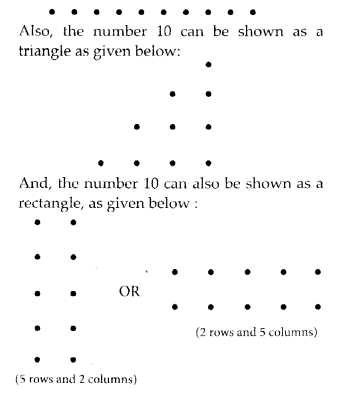
Question 20.
Which of the following statements is not true?
(A) Both addition and multiplication are associative for whole numbers.
(B) Zero is the identity for multiplication of whole numbers.
(C) Addition and multiplication both are commutative for whole numbers.
(D) Multiplication is distributive over addition for whole numbers.
Solution:
(B) : Zero is the identity for addition of whole numbers.
Question 21.
Which of the following statements is not true?
(A) 0 + 0 = 0
(B) 0 – 0 = 0
(C) 0 × 0 = 0
(D) 0 – 0 = 0
Solution:
(D) : 0 + 0 is not defined.
Question 22.
The predecessor of 1 lakh is
(A) 99000
(B) 99999
(C) 999999
(D) 100001
Solution:
(B) : 1 lakh = 100000
∴ Predecessor of 100000 = 100000 – 1 = 99999
Question 23.
The successor of 1 million is
(A) 2 millions
(B) 1000001
(C) 100001
(D) 10001
Solution:
(B) : 1 million = 1000000
∴ Successor of 1000000 = 1000000 + 1 = 1000001
Question 24.
Number of even numbers between 58 and 80 is
(A) 10
(B) 11
(C) 12
(D) 13
Solution:
(A) : Even numbers between 58 and 80 are 60, 62, 64, 66, 68, 70, 72, 74, 76, 78.
So, there are 10 even numbers between 58 and 80.
Question 25.
Sum of the number of primes between 16 to 80 and 90 to 100 is
(A) 20
(B) 18
(C) 17
(D) 16
Solution:
(C) : Prime numbers between 16 to 80 are 17, 19, 23, 29, 31, 37, 41, 43, 47, 53, 59, 61, 67, 71, 73 and 79. .
So, there are 16 prime numbers between 16 to 80.
Also, 97 is the only prime number between 90 to 100.
So, there is only 1 prime number between 90 to 100.
∴ Required sum = 16 + 1 = 17
Question 26.
Which of the following statements is not true?
(A) The HCF of two distinct prime numbers is 1
(B) The HCF of two coprime numbers is 1
(C) The HCF of two consecutive even numbers is 2
(D) The HCF of an even and an odd number is even
Solution:
(D) : The HCF of an even and an odd number is always an odd number.
Question 27.
The number of distinct prime factors of the largest 4-digit number is
(A) 2
(B) 3
(C) 5
(D) 11
Solution:
(B) : The largest 4-digit number is 9999. Now,
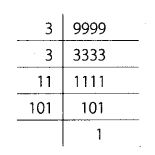
9999 = 3 × 3 × 11 × 101
So, distinct prime factors of 9999 are 3,11 and 101, i.e., 3 distinct prime factors.
Question 28.
The number of distinct prime factors of the smallest 5-digit number is
(A) 2
(B) 4
(C) 6
(D) 8
Solution:
(A) : The smallest 5-digit number is
10000.
Now,

∴ 10000 = 2 × 2 × 2 × 2 × 5 × 5 × 5 × 5
So, distinct prime factors of 10000 are 2 and 5, i.e., 2 distinct prime factors.
Question 29.
If the number 7254 * 98 is divisible by 22, the digit at * is
(A) 1
(B) 2
(C) 6
(D) 0
Solution:
(C) : 7254 * 98 is divisible by 22, if it is divisible by both 2 and 11.
Given number is even, therefore it is divisible by 2.
7254 * 98 is divisible by 11, if (7 + 5 + * + 8) – (2 + 4 + 9) or (20 + *) – 15 or 5 + * is divisible by 11.
∴ The digit at * should be filled by 6.
Question 30.
The largest number which always divides the sum of any pair of consecutive odd numbers is
(A) 2
(B) 4
(C) 6
(D) 8
Solution :
The sum of any pair of consecutive odd numbers comes in the form of multiple of 4.
∴ The required largest number is 4.
Question 31.
A number is divisible by 5 and 6. It may not be divisible by
(A) 10
(B) 15
(C) 30
(D) 60
Solution :
(D) : The LCM of 5 and 6 is 30.
And 30 is divisible by 10, 15 and 30 but not by 60.
Question 32.
The sum of the prime factors of 1729 is
(A) 13
(B) 19
(C) 32
(D) 39
Solution :
(D) : We have,
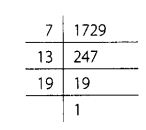
The prime factors of 1729 = 7 x 13 x 19.
∴ The sum of the prime factors of 1729 = 7 + 13 + 19 = 39
Question 33.
The greatest number which always divides the product of the predecessor and successor of an odd natural number other than 1, is
(A) 6
(B) 4
(C) 16
(D) 8
Solution:
(B) : Since the odd natural numbers other than 1 are 3, 5, 7, 9 and so on.
Now, the predecessor and successor of 3 are 2 and 4 respectively, and their product is 2 × 4 = 8
Similarly, the predecessor and successor of 5 are 4 and 6 respectively and their product is 4 × 6 = 24 and so on.
Thus, above shows that the greatest number which always divides the product of the predecessor and successor of an odd natural other than 1 is 4.
Question 34.
The number of common prime factors of 75, 60, 105 is
(A) 2
(B) 3
(C) 4
(D) 5
Solution:
(A) : We have,

75 = 3 × 5 × 5
60 = 2 × 2 × 3 × 5
105 = 3 × 5 × 7
The common prime factors of 75, 60 and 105 are 3 and 5 i.e., 2 in number.
Question 35.
Which of the following pairs is not coprime?
(A) 8, 10
(B) 11, 12
(C) 1, 3
(D) 31, 33
Solution:
(A) : 8 and 10 are not co-prime numbers.
∴ Their common factor other than 1 is 2.
Question 36.
Which of the following numbers is divisible by 11?
(A) 1011011
(B) 1111111
(C) 22222222
(D) 3333333
Solution:
(C) : The difference of the sum of digits of 22222222 at even and odd places is 0.
∴ It must be divisible by 11.
Question 37.
LCM of 10,15 and 20 is
(A) 30
(B) 60
(C) 90
(D) 180
Solution:
(B) : We have,
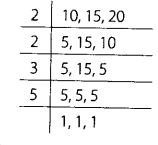
The LCM of 10, 15 and 20 is 2 × 2 × 3 × 5 = 60
Question 38.
LCM of two numbers is 180. Then which of the following is not the HCF of the numbers?
(A) 45
(B) 60
(C) 75
(D) 90
Solution:
(C) : We have,

∴ The factors of 180 = 2 × 2 × 3 × 3 × 5
∴ 75 does not divide 180
∴ 75 can not be the HCF of the numbers whose LCM is 180.
Directions: In questions 39 to 98 state whether the given statements are true (T) or false (F).
Question 39.
In Roman numeration, a symbol is not repeated more than three times.
Solution:
True
Question 40.
In Roman numeration, if a symbol is repeated, its value is multiplied as many times as it occurs.
Solution:
False
If a symbol is repeated, then its value is added as many times as it occurs in Roman numeration.
Question 41.
5555 = 5 × 1000 + 5 × 100 + 5 × 10 + 5 × 1
Solution:
True
Question 42.
39746 = 3 × 10000 + 9 × 1000 + 7 × 100 + 4 × 10 + 6
Solution:
True
Question 43.
82546 = 8 × 1000 + 2 × 1000 + 5 × 100 + 4 × 10 + 6
Solution:
False
Since, 82546 = 8 × 10000 + 2 × 1000 + 5 × 100 + 4 × 10 + 6
Question 44.
532235 = 5 × 100000 + 3 × 10000 + 2 × 1000 + 2 × 100 + 3 × 10 + 5
Solution:
True
Question 45.
XXIX = 31
Solution:
False
Since, XXIX = 29
Question 46.
LXXIV = 74
Solution:
True
Question 47.
The number LIV is greater than LVI.
Solution:
False
Since, LIV = 54 and LVI = 56
∴ LVI is greater than LIV.
Question 48.
The numbers 4578, 4587, 5478, 5487 are in descending order.
Solution:
False
Since, the numbers 4578, 4587, 5478, 5487 are in ascending order.
Question 49.
The number 85764 rounded off to nearest hundreds is written as 85700.
Solution:
False
∴ The number 85764 rounded off to nearest hundreds is 85800.
Question 50.
Estimated sum of 7826 and 12469 rounded off to hundreds is 20,000.
Solution:
False
Round off 7826 to hundreds is 7800.
Round off 12469 to hundreds is 12500.
∴ Required sum = 7800 + 12500 = 20300
Question 51.
The largest six digit telephone number that can be formed by using digits 5, 3, 4, 7, 0, 8 only once is 875403.
Solution:
False
∴ The largest six digit telephone number that can be formed by using digits 5, 3, 4, 7, 0, 8 only once is 875430.
Question 52.
The number 81652318 will be read as eighty one crore six lakh fifty two thousand three hundred eighteen.
Solution:
False
∴ The number 81652318 will be read as eight crore sixteen lakh fifty two thousand three hundred eighteen.
Question 53.
The largest 4-digit number formed by the digits 6, 7, 0, 9 using each digit only once is 9760.
Solution:
True
Question 54.
Among kilo, milli and centi, the smallest is centi.
Solution:
False
Among kilo, milli and centi, the smallest is milli.
Question 55.
Successor of a one digit number is always a one digit number.
Solution:
False
∴ The successor of a one digit number 9 is a two digit number, i.e., 10.
Question 56.
Successor of a 3-digit number is always a 3- digit number.
Solution:
False
∴ The successor of a 3-digit number 999 is a 4- digit number, i.e., 1000.
Question 57.
Predecessor cf a two digit number is always a two digit number.
Solution:
False
∴ The predecessor of a two digit number 10 is a one digit number, i.e., 9.
Question 58.
Every whole number has its successor.
Solution:
True
Question 59.
Every whole number has its predecessor.
Solution:
False
∴ 0 is a whole number and it does not have any predecessor.
Question 60.
Between any two natural numbers, there is one natural number.
Solution:
False
Since, 1 and 2 are two natural numbers and there is no natural number between 1 and 2.
Question 61.
The smallest 4-digit number is the successor of the largest 3-digit number.
Solution:
True
∴ The smallest 4-digit number is 1000, i.e., 999 + 1 and the largest 3-digit number is 999.
Question 62.
Of the given two natural numbers, the one having more digits is greater.
Solution:
True
Question 63.
Natural numbers are closed under addition.
Solution:
True
∴ The sum of two natural numbers is also a natural number.
Question 64.
Natural numbers are not closed under multiplication.
Solution:
False
∴ The multiplication of two natural numbers is also a natural number.
Question 65.
Natural numbers are closed under subtraction.
Solution:
False
∵ 2 and 5 are natural numbers, but their subtraction, 2 – 5 = – 3 is not a natural number.
Question 66.
Addition is commutative for natural numbers.
Solution:
True
Since, a + b = b + a, where ‘a’ and ‘b’ are natural numbers.
Question 67.
1 is the identity for addition of whole numbers.
Solution:
False
∵ 0 is the identity for addition of whole numbers.
As 0 + a = a + 0 = a, where ‘a’ is any whole number.
Question 68.
1 is the identity for multiplication of whole numbers.
Solution:
True
∵ a × 1 = 1 × a = a, where ‘a’ is any whole number.
Question 69.
There is a whole number which when added to a whole number, gives the number itself.
Solution:
True
Question 70.
There is a natural number which when added to a natural number, gives the number itself.
Solution:
False
Question 71.
If a whole number is divided by another whole number, which is greater than the first one, the quotient is not equal to zero.
Solution:
True
Question 72.
Any non-zero whole number divided by itself gives the quotient 1.
Solution:
True
Question 73.
The product of two whole numbers need not be a whole number.
Solution:
False
∵ The product of any two whole numbers will always be a whole number.
Question 74.
A whole number divided by another whole number greater than 1 never gives the quotient equal to the former.
Solution:
True
Question 75.
Every multiple of a number is greater than or equal to the number.
Solution:
True
Question 76.
The number of multiples of a given number is finite.
Solution:
False
Since, the number of multiples of a given number is infinite.
Question 77.
Every number is a multiple of itself.
Solution:
True
Question 78.
Sum of two consecutive odd numbers is always divisible by 4.
Solution:
True
Question 79.
If a number divides three numbers exactly, it must divide their sum exactly.
Solution:
True
Question 80.
If a number exactly divides the sum of three numbers, it must exactly divide the numbers separately.
Solution:
False
Question 81.
If a number is divisible both by 2 and 3, then it is divisible by 12.
Solution:
False
Since, a number is divisible by both 2 and 3 implies that it is also divisible by 6.
Question 82.
A number with three or more digits is divisible by 6, if the number formed by its last two digits (i.e., ones and tens) is divisible by 6.
Solution:
False
A number is divisible bv 6 if the number is divisible by both 2 and 3.
Question 83.
A number with 4 or more digits is divisible by 8, if the number formed by the last three digits is divisible by 8.
Solution:
True
Question 84.
If the sum of the digits of a number is divisible by 3, then the number itself is divisible by 9.
Solution:
False
If the sum of the digits of a number is divisible by 3, then the number itself is divisible by 3.
Question 85.
All numbers which are divisible by 4 may not be divisible by 8.
Solution:
True
Since, 12 is divisible by 4 but not by 8.
Question 86.
The Highest Common Factor of two or more numbers is greater than their Lowest Common Multiple.
Solution:
False
∵ HCF of two or more numbers is smaller than their LCM.
Question 87.
LCM of two or more numbers is divisible by their HCF.
Solution:
True
Question 88.
LCM of two numbers is 28 and their HCF is 8.
Solution:
False
The LCM of two numbers i.c., 28 is not divisible by their HCF, i.e., 8.
Their HCF cannot be 8.
Question 89.
LCM of two or more numbers may be one of the numbers.
Solution:
True
Question 90.
HCF of two or more numbers may be one of the numbers.
Solution:
True
Question 91.
Every whole number is the successor of another whole number.
Solution:
False
∵ 0 is a whole number but it is not a successor of any whole number.
Question 92.
Sum of two whole numbers is always less than their product.
Solution:
False
∵ product of two whole numbers may or may not be greater than their sum.
Question 93.
If the sum of two distinct whole numbers is odd, then their difference also must be odd.
Solution:
True
Question 94.
Any two consecutive numbers are coprime.
Solution:
True
∵ The common factor of any two consecutive numbers is 1.
Question 95.
If the HCF of two numbers is one of the numbers, then their LCM is the other number.
Solution:
True
∵ The product of two numbers = HCF × LCM.
Question 96.
The HCF of two numbers is smaller than the smaller of the numbers.
Solution:
False
Since, HCF of two numbers is less than or equal to the smaller of the numbers.
Question 97.
The LCM of two numbers is greater than the larger of the numbers.
Solution:
False
Since, LCM of two numbers is greater than or equal to the larger of the numbers.
Question 98.
The LCM of two coprime numbers is equal to the product of the numbers.
Solution:
True
Directions: In questions 99 to 150, fill in the blanks to make the statements true.
Question 99.
(a) 10 million = crore.
(b) 10 lakh = million.
Solution:
(a) 1
(b) 1
Question 100.
(a) 1 metre = ____millimetres.
(b) 1 centimetre = ____ millimetres.
(c) 1 kilometre = ____ millimetres.
Solution:
(a) 1000,
(b) 10,
(c) 10, 00, 000
Question 101.
(a) 1 gram = ___ milligrams.
(b) 1 litre = ___ millilitres.
(c) 1 kilogram = ___ milligrams.
Solution:
(a) 1000,
(b) 1000,
(c) 10,00,000
Question 102.
100 thousands = ___ lakh.
Solution:
1
Question 103.
Height of a person is 1 m 65 cm. His height in millimetres is ___.
Solution:
1650 : 1 m 65 cm = (1000 + 650) mm = 1650 mm
Question 104.
Length of river ‘Narmada’ is about 1290 km. Its length in metres is ___ .
Solution:
1290000 : 1290 km = (1290 × 1000) m = 1290000 m
Question 105.
The distance between Srinagar and Leh is 422 km. The same distance in metres is ___.
Solution:
422000 : 422 km= (422 × 1000) m = 422000 m
Question 106.
Writing of numbers from the greatest to the smallest is called an arrangement in ___ order.
Solution:
Descending
Question 107.
By reversing the order of digits of the greatest number made by five different non-zero digits, the new number is the number of ___ five digits.
Solution:
Smallest*
* By reversing the order of digits of the greatest number made by five different non-zero digits, the new number is the smallest number of these digits.
Question 108.
By adding 1 to greatest ___ digit number, we get ten lakh.
Solution:
6 : Greatest 6-digit number = 999999
By adding 1 to 999999, we get 1000000.
Question 109.
The number five crore twenty three lakh seventy eight thousand four hundred one can be written, using commas, in the Indian System of Numeration as .
Solution:
5, 23, 78, 401
Question 110.
In Roman Numeration, the symbol X can be subtracted from ___, M and C only.
Solution:
L
Question 111.
The number 66 in Roman numerals is .
Solution:
LXVI : 66 = LXVI
Question 112.
The population of Pune was 2,538,473 in 2001. Rounded off to nearest thousands, the population was ___.
Solution:
2,538,000
Question 113.
The smallest whole number is ___.
Solution:
0 : 0 is the smallest whole number.
Question 114.
Successor of 106159 is ___.
Solution:
106160 : Successor of 106159 is 106159 + 1, i.e., 106160
Question 115.
Predecessor of 100000 is ___.
Solution:
99999 : Predecessor of 100000 is 100000-1, i.e., 99999
Question 116.
400 is the predecessor of ___.
Solution:
401 : 400 is the predecessor of 400 + 1, i.e., 401
Question 117.
___ is the successor of the largest 3 digit number.
Solution:
1000 : Largest 3 digit number = 999
Successor of 999 is 999 + 1, i.e., 1000
Question 118.
If 0 is subtracted from a whole number, then the result is the ___ itself.
Solution:
Number
Question 119.
The smallest 6 digit natural number ending in 5 is ___.
Solution:
100005
Question 120.
Whole numbers are closed under ___ and under ___.
Solution:
Addition, multiplication
Question 121.
Natural numbers are closed under ___ and under ___.
Solution:
Addition, multiplication
Question 122.
Division of a whole number by ___ is not defined.
Solution:
0
Question 123.
Multiplication is distributive over ___ for whole numbers.
Solution:
Addition
Question 124.
2395 × ___ = 6195 × 2395
Solution:
6195 : Since, multiplication is commutative for whole numbers.
Question 125.
1001 × 2002 = 1001 × (1001 + ___)
Solution:
1001
Question 126.
10001 × o =
Solution:
0
Question 127.
2916 × ___ = 0
Solution:
0
Question 128.
9128 × ___ = 9128
Solution:
1 : Since, 1 is the multiplicative identity for whole numbers.
Question 129.
125 + (68 + 17) = (125 + ___ ) + 17
Solution:
68 : Since, addition is associative for whole numbers.
Question 130.
8925 × 1 =
Solution:
8925
Question 131.
19 × 12 + 19= 19 × (12 + ___)
Solution:
1 : Since, multiplication is distributive over addition for whole numbers.
Question 132.
24 × 35 = 24 × 18 + 24 × ___
Solution:
17
Question 133.
32 × (27 × 19) = (32 × ___ ) × 19
Solution:
27 : Since, multiplication is associative for whole numbers.
Question 134.
786 × 3 + 786 × 7 = ___
Solution:
7860 : 786 × 3 + 786 × 7 = 786 × (3 + 7)
= 786 × 10 = 7860
Question 135.
![]()
Solution:
100
Question 136.
A number is a ___ of each of its factor.
Solution:
Multiple
Question 137.
___ is a factor of every number.
Solution:
1
Question 138.
The number of factors of a prime number is ___
Solution:
2
Question 139.
A number for which the sum of all its factors is equal to twice the number is called a ___ number.
Solution:
Perfect
Question 140.
The numbers having more than two factors are called ___ numbers.
Solution:
Composite
Question 141.
2 is the only ___ number which is even.
Solution:
Prime
Question 142.
Two numbers having only 1 as a common factor are called ___ numbers.
Solution:
Co-prime
Question 143.
Number of primes between 1 to 100 is ___
Solution:
25 : Prime numbers between 1 to 100 are 2, 3, 5, 7, 11, 13, 17, 19, 23, 29, 31, 37, 41, 43, 47, 53, 59, 61, 67, 71, 73, 79, 83, 89, 97.
So, there are 25 primes between 1 to 100.
Question 144.
If a number has ___ in ones place, then it is divisible by 10.
Solution:
0
Question 145.
A number is divisible by 5, if it has ___ or ___ in its ones place.
Solution:
0, 5
Question 146.
A number is divisible by ___ if it has any of the digits 0, 2, 4, 6, or 8 in its ones place.
Solution:
2
Question 147.
If the sum of the digits in a number is a ___ of 3, then the number is divisible by 3.
Solution:
Multiple
Question 148.
If the difference between the sum of digits at odd places (from the right) and the sum of digits at even places (from the right) of a number is either 0 or divisible by ___, then the number is divisible by 11.
Solution:
11
Question 149.
The LCM of two or more given numbers is the lowest of their common ___.
Solution:
Multiple
Question 150.
The HCF of two or more given numbers is the highest of their common ___.
Solution:
Factors
Question 151.
Given below are two columns – Column I and Column II. Match each item of Column I with the corresponding item of Column II.
| Column I | Column II |
| (i) The difference of two consecutive whole numbers | (a) odd |
| (ii) The product of two non-zero consecutive whole numbers | (b) 0 |
| (iii) Quotient when zero is divided by another non-zero whole number | (c) 3 |
| (iv) 2 added three times, to the smallest whole number | (d) 1 |
| (v) smallest odd prime number | (e) 6 |
| (f) even |
Solution:
(i) ➝ (d) ; (ii) ➝ (f) ; (iii) ➝ (b) ; (iv) ➝ (e) ; (v) ➝ (c)
Question 152.
Arrange the following numbers in descending order:
8435.4835.13584, 5348, 25843
Solution:
Descending order of given numbers is,
25843, 13584, 8435, 5348, 4835
Question 153.
Of the following numbers which is the greatest? Which is the smallest?
38051425, 30040700, 67205602
Solution:
The greatest number is 67205602 and the smallest number is 30040700.
Question 154.
Write in expanded form :
(a) 74836
(b) 574021
(c) 8907010
Solution:
(a) 74836 = 7 × 10000 + 4 × 1000 + 8 × 100 + 3 × 10 + 6 × 1
(b) 574021 = 5 × 100000 + 7 × 10000 + 4 x 1000 + 0 × 100 + 2 × 10 + 1 × 1
(c) 8907010 = 8 × 1000000 + 9 × 100000 + 0 × 10000 + 7 × 1000 + 0 × 100 + 1 × 10 + 0 × 1
Question 155.
As per the census of 2001, the population of four states are given below. Arrange the states in ascending and descending order of their population.
(a) Maharashtra 96878627
(b) Andhra Pradesh 76210007
(c) Bihar 82998509
(d) Uttar Pradesh 166197921
Solution:
Ascending order ➝ (b), (c), (a), (d)
Descending order ➝ (d), (a), (c), (b)
Question 156.
The diameter of Jupiter is 142800000 metres. Insert commas suitably and write the diameter according to International System of Numeration.
Solution:
The diameter of Jupiter is 142,800,000 metres.
Question 157.
India’s population has been steadily increasing from 439 millions in 1961 to 1028 millions in 2001. Find the total increase in population from 1961 to 2001. Write the increase in population in Indian System of Numeration, using commas suitably.
Solution:
Total increase in population from 1961 to 2001= 1028 millions – 439 millions = 589 millions
According to Indian System of Numeration, the increase in population = 58,90,00,000
Question 158.
Radius of the Earth is 6400 km and that of Mars is 4300000 m. Whose radius is bigger and by how much?
Solution:
Radius of the Earth = 6400 km = 6400 × 1000 m = 6400000 m
And radius of the Mars = 4300000 m
∴ Radius of the Earth is greater than the radius of the Mars by (6400000 – 4300000) m = 2100000 m.
Question 159.
In 2001, the populations of Tripura and Meghalaya were 3,199,203 and 2,318,822, respectively. Write the populations of these two states in words.
Solution:
The population of Tripura = 3,199,203 i.e., Three million one hundred ninety-nine thousand two hundred three.
And the population of Meghalaya = 2,318,822, i.e., Two million three hundred eighteen thousand eight hundred twenty two.
Question 160.
In a city, polio drops were given to 2,12,583 children on Sunday in March 2008 and to 2,16,813 children in the next month. Find the difference of the number of children getting polio drops in the two months.
Solution:
Number of children getting polio drops in March 2008 = 2,12,583
Number of children getting polio drops in April 2008 = 2,16,813
∴ The required difference of the number of children getting polio drops in the two months = 2,16,813 – 2,12,583 = 4,230
Question 161.
A person had ₹ 1000000 with him. He purchased a colour T.V. for ₹ 16580, a motor cycle for ₹ 45890 and a flat for ₹ 870000. How much money was left with him?
Solution:
Total amount a person had = ₹ 1000000
The amount he spent on a colour T.V. = ₹ 16580
The amount he spent on a motorcycle = ₹ 45890
The amount he spent on a flat = ₹ 870000
∴ Total amount he spent = ₹ (16580 + 45890 + 870000) = ₹ 932470
Thus, the amount left with him = ₹ 1000000 – ₹ 932470 = ₹ 67530
Question 162.
Out of 180000 tablets of Vitamin A, 18734 are distributed among the students in a district. Find the number of the remaining vitamin tablets.
Solution:
Total tablets of Vitamin A = 180000
Number of tablets distributed among the students in a district = 18734
∴ The number of remaining vitamin tablets = 180000 – 18734 = 161266
Question 163.
Chinmay had ₹ 610000. He gave ₹ 87500 to Jyoti, ₹ 126380 to Javed and ₹ 350000 to John. How much money was left with him?
Solution:
Chinmay had total amount = ₹ 610000
The amount he gave to Jyoti = ₹ 87500
The amount he gave to Javed = ₹ 126380
The amount he gave to John = ₹ 350009
Total amount given by Chinmay = ₹ (87500 + 126380 + 350000) = ₹ 563880
Thus, the amount left with him
= ₹ 610000 – ₹ 563880 = ₹ 46120
Question 164.
Find the difference between the largest number of seven digits and the smallest number of eight digits.
Solution:
The smallest number of eight digits = 10000000
The largest number of seven digits = 9999999
The required difference = 10000000 – 9999999 = 1
Question 165.
A mobile number consists of ten digits. The first four digits of the number are 9, 9, 8 and 7. The last three digits are 3, 5 and 5. The remaining digits are distinct and make the mobile number, the greatest possible number. What are these digits?
Solution:
A mobile number consists of 10 digits.
If the first four digits of the number are 9, 9, 8 and 7 and the last three digits of the number are 3, 5 and 5.
Thus, for the greatest possible number, the remaining distinct digits are 6, 4 and 2.
Question 166.
A mobile number consists of ten digits. First four digits are 9,9, 7 and 9. Make the smallest mobile number by using only one digit twice from 8, 3, 5, 6, 0.
Solution:
A mobile number consists of 10 digits.
If the first four digits are 9, 9, 7 and 9.
Thus, the smallest mobile number by using only one digit twice from 8, 3, 5, 6, 0 is 9979003568.
Question 167.
In a five digit number, digit at ten’s place is 4, digit at unit’s place is one fourth of ten’s place digit, digit at hundred’s place is 0, digit at thousand’s place is 5 times of the digit at unit’s place and ten thousand’s place digit is double the digit at ten’s place. Write the number.
Solution:
A number consists of 5 digits.
Now, the digit at ten’s place = 4,
the digit at unit’s place
![]()
the digit at hundred’s place = 0,
the digit at thousand’s place = 5 × 1 = 5
the digit at ten thousand’s place = 2 × 4 = 8
Therefore, the number is 85041.
Question 168.
Find the sum of the greatest and the least six digit numbers formed by the digits 2, 0, 4, 7, 6, 5 using each digit only once.
Solution:
By using the digits 2, 0, 4, 7, 6, 5
The greatest number formed = 765420,
and the least number formed = 204567
∴ The required sum = 765420 + 204567 = 969987
Question 169.
A factory has a container filled with 35874 litres of cold drink. In how many bottles of 200 ml capacity each can it be filled?
Solution:
Quantity of cold drink in a container = 35874 litres = 35874 × 1000 ml = 35874000 ml
The capacity of one bottle = 200 ml
∴ The required number of bottles = 35874000 ÷ 200 = 179370
Therefore, 179370 bottles can be filled by cold drink.
Question 170.
The population of a town is 450772. In a survey, it was reported that one out or every 14 persons is illiterate. In all how many illiterate persons are there in the town?
Solution:
Total population of a town = 450772
Since, one out of every 14 persons is illiterate.
∴ The number of illiterate persons in the town = 450772 ÷ 14 = 32198
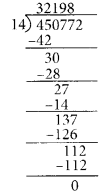
Therefore, 32198 persons are illiterate in the town
Question 171.
Find the LCM of 80, 96, 125, 160
Solution:
we have,
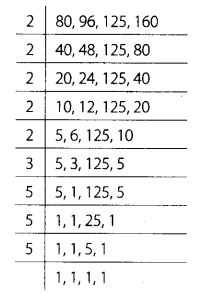
The LCM of 80, 96, 125 and 160 is
= 2 × 2 × 2 × 2 × 2 × 3 × 5 × 5 × 5 = 12000
Question 172.
Make the greatest and the smallest 5-digit numbers using different digits in which 5 appears at ten’s place.
Solution:
By using the digit 5 at ten’s place, the greatest 5-digit number is 98756, and the smallest 5-digit number is 10253
Question 173.
How many grams should be added to 2 kg 300 g to make it 5 kg 68 g?
Solution:
5 kg 68 g = (5 × 1000 + 68) g = 5068 g and 2 kg 300 g = (2 × 1000 + 300) g = 2300 g
∴ The required number of grams should be added = 5068 g – 2300 g = 2768 g or 2 kg 768 g
Question 174.
A box contains 50 packets of biscuits each weighing 120 g. How many such boxes can be loaded in a van which cannot carry beyond 900 kg?
Solution:
The total weight of a box containing 50 packets of biscuits each weighing 120 g
= 50 × 120 g = 6000 g
The capacity of a van = 900 kg = 900 × 1000 g = 900000 g
∴ The required number of boxes = 900000 + 6000 = 150
Therefore, 150 boxes can be loaded in the van.
Question 175.
How many lakhs make five billions?
Solution:
50000 lakhs make 5 billions.
Question 176.
How many millions make 3 crores?
Solution:
30 millions make 3 crores.
Question 177.
Estimate each of the following by rounding off each number to nearest hundreds:
(a) 874 + 478
(b) 793 + 397
(c) 11244 + 3507
(d) 17677 + 13589
Solution:
(a) 874 rounded off to the nearest hundreds = 900
478 rounded off to the nearest hundreds = 500
Estimated sum = 900 + 500 = 1400
(b) 793 rounded off to the nearest hundreds = 800
397 rounded off to the nearest hundreds = 400
Estimated sum = 800 + 400 = 1200
(c) 11244 rounded off to the nearest hundreds =11200
3507 rounded off to the nearest hundreds = 3500
Estimated sum = 11200 + 3500 = 14700
(d) 17677 rounded off to the nearest hundreds =17700
13589 rounded off to the nearest hundreds =13600
Estimated sum = 17700 + 13600 = 31300
Question 178.
Estimate each of the following by rounding off each number to nearest tens :
(a) 11963 – 9369
(b) 76877 – 7783
(c) 10732 – 4354
(d) 78203 -16407
Solution:
(a) 11963 rounded off to the nearest tens = 11960
9369 rounded off to the nearest tens = 9370
Estimated difference = 11960 – 9370 = 2590
(b) 76877 rounded off to the nearest tens = 76880
7783 rounded off to the nearest tens = 7780
Estimated difference = 76880 – 7780 = 69100
(c) 10732 rounded off to the nearest tens =10730
4354 rounded off to the nearest tens = 4350
Estimated difference = 10730 – 4350 = 6380
(d) 78203 rounded off to the nearest tens = 78200
16407 rounded off to the nearest tens =16410
Estimated difference = 78200 – 16410 = 61790
Question 179.
Estimate each of the following products by rounding off each number to nearest tens:
(a) 87 × 32
(b) 311 × 113
(c) 3239 × 28
(d) 1385 × 789
Solution:
(a) 87 rounded off to the nearest tens = 90
32 rounded off to the nearest tens = 30
Estimated product = 90 × 30 = 2700
(b) 311 rounded off to the nearest tens = 310
113 rounded off to the nearest tens = 110
Estimated product = 310 x 110 = 34100
(c) 3239 rounded off to the nearest tens = 3240
28 rounded off to the nearest tens = 30
Estimated product = 3240 × 30 = 97200
(d) 1385 rounded off to the nearest tens = 1390
789 rounded off to the nearest tens = 790
Estimated product = 1390 × 790 = 1098100
Question 180.
The population of a town was 78787 in the year 1991 and 95833 in the year 2001. Estimate the increase in population by rounding off each population to nearest hundreds.
Solution:
78787 rounded off to the nearest hundreds = 78800
95833 rounded off to the nearest hundreds = 95800
The estimated increase in population = 95800 – 78800 = 17000
Question 181.
Estimate the product 758 × 6784 using the general rule.
Solution:
758 can be rounded off to 800 and 6784 can be rounded off to 7000
∴ Estimated product = 800 × 7000 = 5600000
Question 182.
A garment factory produced 216315 shirts, 182736 trousers and 58704 jackets in a year. What is the total production of all the three items in that year?
Solution:
Number of shirts produced by the factory = 216315
Number of trousers produced by the factory =182736
Number of jackets produced by the factory = 58704
Total production of the factory = 216315 + 182736 + 58704 = 457755
Question 183.
Find the LCM of 160,170 and 90.
Solution:
We have,
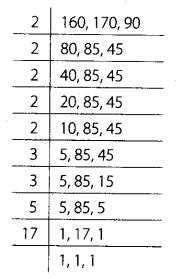
The LCM of 160,170 and 190 =2 × 2 × 2 × 2 × 2 × 3 × 3 × 5 × 17 = 24480
Question 184.
A vessel has 13 litres 200 mL of fruit juice. In how many glasses each of capacity 60 mL can it be filled?
Solution:
Quantity of fruit juice in a vessel = 13 L 200 mL = (13 × 1000 + 200) mL = 13200 mL
Capacity of one glass = 60 mL
∴ The required number of glasses = 13200 ÷ 60 = 220
Therefore, 220 glasses can be filled by fruit juice.
Question 185.
Determine the sum of the four numbers as given below:
(a) successor of 32
(b) predecessor of 49
(c) predecessor of the predecessor of 56
(d) successor of the successor of 67
Solution:
Since, successor of 32 is 33, predecessor of 49 is 48, predecessor of the predecessor of 56 is 54 and successor of the successor of 67 is 69.
∴ The required sum = 33 + 48 + 54 + 69 = 204
Question 186.
A loading tempo can carry 482 boxes of biscuits weighing 15 kg each, whereas a van can carry 518 boxes each of the same weight. Find the total weight that can be carried by both the vehicles.
Solution:
Total weight can be carried by a tempo = (482 × 15) kg = 7230 kg and the total weight can be carried by a van = (518 × 15) kg = 7770 kg Thus, the total weight that can be carried by both the vehicles = (7230 + 7770) kg = 15000 kg
Question 187.
In the marriage of her daughter, Leela spent ₹ 216766 on food and decoration, ₹ 122322 on jewellery, ₹ 88234 on furniture and ₹ 26780 on kitchen items. Find the total amount spent by her on the above items.
Solution:
Amount spent by Leela on food and decoration = ₹ 216766
Amount spent by her on jewellery = ₹ 122322
Amount spent by her on furniture = ₹ 88234
Amount spent by her on kitchen items = ₹ 26780
∴ Total amount spent by her = ₹ (216766 + 122322 + 88234 + 26780)
= ₹ 454102
Question 188.
A box contains 5 strips each having 12 capsules of 500 mg medicine in each capsule. Find the total weight in grams of medicine in 32 such boxes.
Solution:
Quantity of medicine in one capsule = 500 mg
∴ Quantity of medicine in 12 capsules or 1 strip = (500 × 12) mg = 6000 mg = 6 g
Quantity of medicine in 5 strips or 1 box = (6 × 5) g = 30 g
Quantity of medicine in 32 boxes = (30 × 32)g = 960 g
Question 189.
Determine the least number which when divided by 3, 4 and 5 leaves remainder 2 in each case.
Solution:
We have,

Since, the LCM of 3,4 and 5 is 2 × 2× 3 × 5 = 60.
∴ The required number is 6is the least number which when divided by 3, 4 and 5 leaves remainder 2 in each case.
Question 190.
A merchant has 120 litres of oil of one kind, 180 litres of another kind and 240 litres of a third kind. He wants to sell the oil by filling the three kinds of oil in tins of equal capacity. What should be the greatest capacity of such a tin? .
Solution:
A merchant has 3 kinds of oil with different quantities like 120 litres, 180 litres and 240 litres.
Since, he wants to sell the oil by filling the three kinds of oil in tins of equal capacity, so the greatest capacity of such a tin is the HCF of 120,180 and 240.
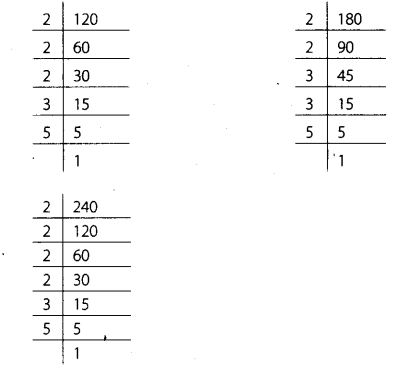
Now 120 = 2 × 2 × 2 × 3 × 5
180 = 2 × 2 × 3 × 3 × 5
240 = 2 × 2 × 2 × 2 × 3 × 4
∴ The required greatest capacity of a tin = (2 × 2 × 3 × 5) litres = 60 litres
Question 191.
Find a 4-digit odd number using each of the digits 1, 2,4 and 5 only once such that when the first and the last digits are interchanged, it is divisible by 4.
Solution:
By using the digits 1, 2, 4 and 5 only once, we get a 4 digit odd number 4521.
When we interchanged its first and last digits we get a new number, i.e., 1524 which is divisible by 4.
Thus, the required number is 4521.
Question 192.
Using each of the digits 1, 2, 3 and 4 only r once, determine the smallest 4-digit number divisible by 4.
Solution:
By using the digits 1, 2, 3 and 4 only once, the smallest 4-digit number which is divisible by 4 is 1324.
Question 193.
Fatima wants to mail three parcels to three village schools. She finds that the postal charges are ? 20, ? 28 and ? 36, respectively. If she wants to buy stamps only of one denomination, what is the greatest denomination of stamps she must buy to mail the three parcels?
EHffll The postal charges to mail three parcels are ₹ 20, ₹ 28 and ₹ 36 respectively.
Also, Fatima wants to buy stamps only of one denomination.
So, to find the greatest denomination of stamps, we find the HCF of 20, 28 and 36.

Now 20 = 2 × 2 ×5
28 = 2 × 2 × 7
36 = 2 × 2 × 3 × 3
∴ The HCF of 20, 28 and 36 is 2 × 2 = 4
So, ₹ 4 is the greatest denomination of stamps, she must buy to mail the three parcels.
Question 194.
Three brands A, B and C of biscuits are available in packets of 12, 15 and 21 biscuits respectively. If a shopkeeper wants to buy an equal number of biscuits, of each brand, what is the minimum number of packets of each brand, he should buy?
Solution:
A shopkeeper has three brands A, B and C of biscuits are available in packets of 12, 15 and 21 biscuits respectively.
Also, a shopkeeper wants to buy equal number of biscuits of each brand for that we need to find the LCM of 12, 15 and 21.
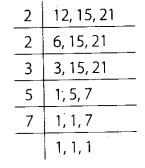
∴ The LCM of 12,15 and 21 = 2 × 2 × 3 × 5 × 7 = 420 Thus, the required number of packets of 420
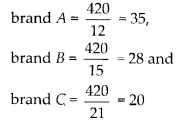
Question 195.
The floor of a room is 8 m 96 cm long and 6 m 72 cm broad. Find the minimum number of square tiles of the same size needed to cover the entire floor.
Solution:
Length of floor of a room = 8 m 96 cm = 896 cm
Breadth of floor of the room = 6 m 72 cm = 672 cm
To find the minimum number of square tiles of same size needed to cover the entire floor, we find the LCM of 896 cm and 672 cm.

∴ LCM of 672 and 896 is 2 × 2 × 2 × 2 × 2 × 2 × 2 × 3 × 7 = 2688

Question 196.
In a school library, there are 780 books of English and 364 books of Science. Ms. Yakang, the librarian of the school wants to store these books in shelves such that each shelf should have the same number of books of each subject. What should be the minimum number of books in each shelf?
Solution:
Number of books of English = 780
Number of books of Science = 364
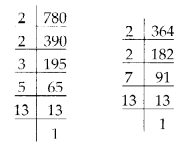
780 = 2 × 2 × 3 × 5 × 13
364 = 2 × 2 × 7 × 13
∴ The HCF of 780 and 364 = 2 × 2 × 13 = 52
Thus, the minimum number of books in each shelf = 52
Question 197 .
In a colony of 100 blocks of flats numbering 1 to 100, a school van stops at every sixth block while a school bus stops at every tenth block. On which stops will both of them stop if they start from the entrance of the colony?
Solution:
There are 100 blocks in a colony numbering 1 to 100.
A school van stops at every sixth block and a school bus stops at every tenth block.
We have to find the common stops at which they both stop if they start from a same entrance.
∴ We need to find the LCM of 6 and 10
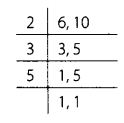
The LCM of 6 and 10 is 2 × 3 × 5 = 30. Firstly both will stop at 30th block, then aL 60th block and lastly at 90th block.
Question 198.
Test the divisibility of following numbers by 11
(a) 5335
(b) 9020814
Solution:
(a) We have the difference between the sum of digits at odd places (from the right) and the sum of digits at even places (from the right) of a number 5335 is (5 + 3) – (3 + 5) = 8 – 8 = 0, which is divisible by 11.
∴ 5335 is divisible by 11.
(b) We have the difference between the sum of digits at odd places (from the right) and the sum of digits at even places (from the right) of the number 9020814 is
(4 + 8 + 2 + 9) – (1 + 0 + 0) = 23 – 1 = 22, which is divisible by 11.
∴ 9020814 is divisible by 11.
Question 199.
Using divisibility tests, determine which of the following numbers are divisible by 4?
(a) 4096
(b) 21084
(c) 31795012
Solution:
(a) We have, 4096
Since, the last two digits 96 is divisible by 4.
∴ 4096 must be divisible by 4.
(b) We have, 21084
Since, the last two digits 84 is divisible by 4.
∴ 21084 must be divisible by 4.
(c) We have, 31795012
Since, the last two digits 12 is divisible by 4.
∴ 31795012 must be divisible by 4.
Question 200.
Using divisibility test determine which of the following numbers are divisible by 9?
(a) 672
(b) 5652
Solution:
(a) We have, 672
Since, the sum of all the digits of 672 is 15, which is not divisible by 9.
∴ 672 is not divisible by 9.
(b) We have, 5652
Since, the sum of all the digits of 5652 is 18, which is divisible by 9.
∴ 5652 must be divisible by 9.
We hope the NCERT Exemplar Class 6 Maths Chapter 1 Number System will help you. If you have any query regarding NCERT Exemplar Class 6 Maths Solutions Chapter 1 Number System, drop a comment below and we will get back to you at the earliest.